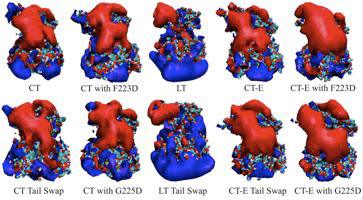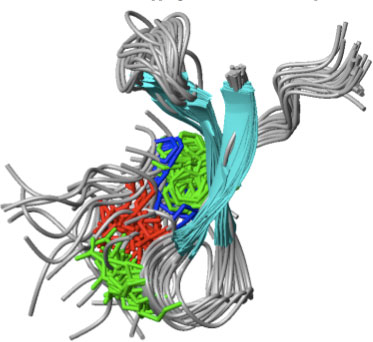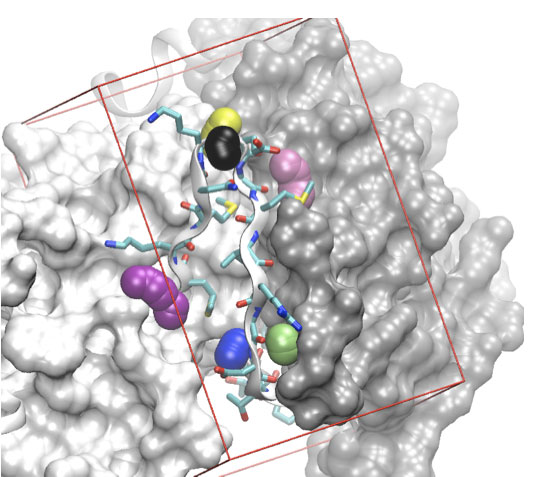Faculty Profile
 John W. Craft Jr.
John W. Craft Jr.
Research Associate Professor
Department of Biology and Biochemistry
Office: Houston Science Center, 358
Contact: jwcraft@uh.edu - 281-538-1219
Education: Ph.D., University of Houston; B.S., Aerospace Engineering, Wichita State University
Dr. Craft’s work incorporates molecular modeling, simulation, quantum mechanics, and computational biophysics to develop and refine drug development processes, with regular forays into materials science and polymer chemistry. He has deployed his computational expertise in a broad range of drug discovery efforts, from anti-inflammatory compounds, to anti-virals, to modulators of integrin activity. His research activities contribute to the development of therapeutics for infectious diseases, cardiovascular disease, and some types of cancer. Dr. Craft’s research program thus contributes to advances in drug discovery, one of the major research priorities at the University of Houston.

Spleen Tyrosine Kinase (SYK)
Atherosclerotic Cardiovascular Disease is characterized by plaque buildup in arteries. IL-1β is an inflammatory cytokine and is a clinically validated target molecule in this pathway. Three seminal studies, the Canakinumab Anti-Inflammatory Thrombosis Outcomes Study (CANTOS), Low Dose Colchicine for Secondary Prevention of Cardiovascular Disease (LODOCO2), and the Colchicine Cardiovascular Outcomes Trial (COLCOT), have proven the hypothesis that atherosclerosis is an inflammatory disease, and that targeting mechanisms of inflammation can reduce major adverse cardiac events independent of lipid lowering. Integrin signaling through the Spleen Tyrosine Kinase (SYK) is essential for IL-1β production and motivation our Drug Discovery program. A structure based computational screen of 15+ million compounds identified 1037 compounds clustered into five families based on their energy scores, functional groups and Tanimoto scores. Datamining this information using GAUSSIAN, AUTODOCK, GROMACS, and PYTHON tools through the University of Houston computing clusters and on AZURE cloud and streamlined scripts built in CHAT-GPT and GROK3 with follow on analysis of the compounds visually in pyMOL have lead to continue refinement of our hypothesis. A prevalent number of compounds interact with GLU242 and ARG45 along the proposed locus of interface residues. 205 compounds have been synthesized and submitted for integrin signaling assay, integrin/SYK elisa, and FcγRI signaling controls. Three classes of compounds have met the potency metric for identifying hits (10 uM in the integrin signaling assay). Analogs of these classes have been designed and synthesized to develop structure activity relationships (SAR). Docked structures and molecular dynamics simulations will be evaluated in-depth to rationally design compounds that have more favorable protein-small molecule interactions.

Bakthavatsalam D, Craft JW Jr, Kazansky A, Nguyen N, Bae G, Caivano AR, Gundlach CW 4th, Aslam A, Ali S, Gupta S, Lin SY, Parthiban HD, Vanderslice P, Stephan CC, Woodside DG. Identification of Inhibitors of Integrin Cytoplasmic Domain Interactions With Syk. Front Immunol. 2020;132(13). doi: 10.3389/fimmu.2020.575085. PubMed PMID: 33488575 ; PubMed Central PMCID: PMC7819857.
Integrins
The inability of CD8+ T effectors (Teff) to reach tumor cells is an important mechanism of tumor resistance to cancer immunotherapy. The recruitment of these cells to the tumor microenvironment (TME) is regulated by integrins, a family of adhesion molecules that is expressed on T cells. Here we show that 7HP349, a small molecule activator of Lymphocyte function–associated antigen-1 (LFA-1) and very late activation antigen-4 (VLA-4) integrin-cell- adhesion receptors, facilitated the preferential localization of tumor-specific T cells to the tumor and improve antitumor response. 7HP349 monotherapy had modest effects on anti programmed death (PD-1) resistant tumors, whereas combinatorial treatment with anti T-lymphocyte- associated protein 4 (CTLA-4) therapy increased CD8+ Teff intratumoral sequestration and synergized in inducing cancer regression, in cooperation with neutrophils. 7HP349 intratumoral CD8+ Teff enrichment activity depended on CXCL12. We analyzed gene expression profiles using RNA from baseline and on treatment tumor samples of 14 melanoma patients. We identified baseline CXCL12 gene expression may improve response likelihood to anti-CTLA-4 therapies. Our results provided a proof-of-principle demonstration that LFA-1 activation could convert a T cell-exclusionary TME to a T-cell enriched TME through mechanisms involving cooperation with innate immune cells.

Hickman A, Koetsier J, Kurtanich T, Nielsen MC, Winn G, Wang Y, Bentebibel SE, Shi L, Punt S, Williams L, Haymaker C, Chesson CB, Fa'ak F, Dominguez AL, Jones R, Kuiatse I, Caivano AR, Khounlo S, Warier ND, Marathi U, Market RV, Biediger RJ, Craft JW Jr, Hwu P, Davies MA, Woodside DG, Vanderslice P, Diab A, Overwijk WW, Hailemichael Y. LFA-1 activation enriches tumor-specific T cells in a cold tumor model and synergizes with CTLA-4 blockade. J Clin Invest. 2022 Jul 1;132(13). doi: 10.1172/JCI154152. PubMed PMID: 35552271; PubMed Central PMCID: PMC9246385.
- Reyes-Alcaraz A, Qasim H, Merlinsky E, Fox G, Islam T, Medina B, Schwartz RJ, Craft JW Jr, McConnell BK. A Small Molecule That In Vitro Neutralizes Infection of SARS-CoV-2 and Its Most Infectious Variants, Delta, and Omicron. Biomedicines. (2023) Mar 15;11(3):916. doi: 10.3390/biomedicines11030916. PMID: 36979895; PMCID: PMC10046252.
- Hickman A, Koetsier J, Kurtanich T, Nielsen MC, Winn G, Wang Y, Bentebibel SE, Shi L, Punt S, Williams L, Haymaker C, Chesson CB, Fa'ak F, Dominguez AL, Jones R, Kuiatse I, Caivano AR, Khounlo S, Warier ND, Marathi U, Market RV, Biediger RJ, Craft JW Jr, Hwu P, Davies MA, Woodside DG, Vanderslice P, Diab A, Overwijk WW, Hailemichael Y.; LFA-1 activation enriches tumor-specific T cells in a cold tumor model and synergizes with CTLA-4 blockade. J Clinical Invest. (2022) Jul 1;132(13):e154152. doi: 10.1172/JCI154152
- Lydia R. St. Hill, Hung-Vu Tran, Pawilai Chinwangso, Han Ju Lee, Maria D. Marquez, J.W. Craft, Jr. and T. Randall Lee; Antifouling Studies of Unsymmetrical Oligo(ethylene glycol) Spiroalkanedithiol Self-Assembled Monolayers; MACRO (2021)
- Lydia R. St. Hill, J.W. Craft, Jr, P Chinwangso, H Tran, M.D. Marquez and T.R. Lee;Antifouling Coatings Generated from Unsymmetrical Partially 2 Fluorinated Spiroalkanedithiols; ACS Applied Bio Materials Feb 1 (2021) doi.org/10.1021/acsabm.0c01409
- D Bakthavatsalam, J.W. Craft Jr., A Kazansky, N Nguyen, G Bae, A.R. Caivano1, C.W. Gundlach IV, A Aslam, S Ali, S Gupta, S.Y. Lin, H.D. Parthiban, P Vanderslice, C.C. Stephan and D.G. Woodside; Identification of Inhibitors of Integrin Cytoplasmic Domain Interactions With Syk; Front. Immunol., 08 January (2021) 10.3389/fimmu.2020.575085
- Abbasgholizadeh R, Zhang H, Craft JW Jr, Bryan RM Jr, Bark SJ, Briggs JM, Fox RO, Agarkov A, Zimmer WE, Gilbertson SR, Schwartz RJ. Discovery of vascular Rho kinase (ROCK) inhibitory peptides. Exp Biol Med (Maywood). 2019 Aug;244(11):940-951.
- Structural and cellular mechanisms of peptidyl-prolyl isomerase Pin1-mediated enhancement of Tissue Factor gene expression, protein half-life, and pro-coagulant activity. Kurakula K, Koenis DS, Herzik MA Jr., Liu Y, Craft JW Jr., van Loenen PB, Vos M, Tran MK, Versteeg HH, Goumans MTH, Ruf W, de Vries CJM, Şen M. Haematologica. 2018 Mar 15. pii: haematol.2017.183087. doi: 10.3324/haematol.2017.183087.
- Magnetic Resonance Imaging of Atherosclerotic Plaque at Clinically Relevant Field Strengths (1T) by Targeting the Integrin α4β1. Woodside DG, Tanifum EA, Ghaghada KB, Biediger RJ, Caivano AR, Starosolski ZA, Khounlo S, Bhayana S, Abbasi S, Craft JW Jr., Maxwell DS, Patel C, Stupin IV, Bakthavatsalam D, Market RV, Willerson JT, Dixon RAF, Vanderslice P, Annapragada AV. Sci Rep. 2018 Feb 27;8(1):3733. doi: 10.1038/s41598-018-21893-x.
- Cherubin P, Garcia MC, Curtis D, Britt CB, Craft JW Jr, Burress H, Berndt C, Reddy S, Guyette J, Zheng T, Huo Q, Quiñones B, Briggs JM, Teter K. Inhibition of Cholera Toxin and Other AB Toxins by Polyphenolic Compounds. PLoS One. 2016 Nov 9;11(11):e0166477. doi: 10.1371/journal.pone.0166477. PMID: 27829022.
- Craft JW Jr, Shen TW, Brier LM, Briggs JM. Biophysical Characteristics of Cholera Toxin and Escherichia coli Heat-Labile Enterotoxin Structure and Chemistry Lead to Differential Toxicity. J Phys Chem B. 2015 Jan 22;119(3):1048-61. doi: 10.1021/jp506509c. Epub 2014 Nov 5. PubMed PMID: 25322200.
- Craft JW Jr, Zhang H, Charendoff MN, Mindrebo JT, Schwartz RJ, Briggs JM. Associations between the Rho kinase-1 catalytic and PH domain regulatory unit. J Mol Graph Model. 2013 Nov;46:74-82. doi: 10.1016/j.jmgm.2013.09.009. Epub 2013 Oct 4. PubMed PMID: 24149321.
- Rababa'h A, Craft JW Jr, Wijaya CS, Atrooz F, Fan Q, Singh S, Guillory AN, Katsonis P, Lichtarge O, McConnell BK. Protein kinase A and phosphodiesterase-4D3 binding to coding polymorphisms of cardiac muscle anchoring protein (mAKAP). J Mol Biol. 2013 Sep 23;425(18):3277-88. doi: 10.1016/j.jmb.2013.06.014. Epub 2013 Jun 25. PubMed PMID: 23806656; PubMed Central PMCID: PMC3808176.
- Anastasio NC, Gilbertson SR, Bubar MJ, Agarkov A, Stutz SJ, Jeng Y, Bremer NM, Smith TD, Fox RG, Swinford SE, Seitz PK, Charendoff MN, Craft JW Jr, Laezza FM, Watson CS, Briggs JM, Cunningham KA. Peptide inhibitors disrupt the serotonin 5-HT2C receptor interaction with phosphatase and tensin homolog to allosterically modulate cellular signaling and behavior. J Neurosci. 2013 Jan 23;33(4):1615-30. doi: 10.1523/JNEUROSCI.2656-12.2013. PubMed PMID: 23345234; PubMed Central PMCID: PMC3711763.
- Carreño R, Brown WS, Li D, Hernandez JA, Wang Y, Kim TK, Craft JW Jr, Komanduri KV, Radvanyi LG, Hwu P, Molldrem JJ, Legge GB, McIntyre BW, Ma Q. 2E8 binds to the high affinity I-domain in a metal ion-dependent manner: a second generation monoclonal antibody selectively targeting activated LFA-1. J Biol Chem. 2010 Oct 22;285(43):32860-8. doi: 10.1074/jbc.M110.111591. Epub 2010 Aug 19. PubMed PMID: 20724473; PubMed Central PMCID: PMC2963386.
- Sen M, Herzik M, Craft JW Jr, Creath AL, Agrawal S, Ruf W, Legge GB. Spectroscopic Characterization of Successive Phosphorylation of the Tissue Factor Cytoplasmic Region. Open Spectrosc J. 2009 Jan 1;3:58-64. PubMed PMID: 20076769; PubMed Central PMCID: PMC2805860.
- Ampapathi RS, Creath AL, Lou DI, Craft JW Jr, Blanke SR, Legge GB. Order-disorder-order transitions mediate the activation of cholera toxin. J Mol Biol. 2008 Mar 28;377(3):748-60. doi: 10.1016/j.jmb.2007.12.075. Epub 2008 Jan 5. PubMed PMID: 18272180; PubMed Central PMCID: PMC2441595.
- Craft JW Jr, Legge GB. An AMBER/DYANA/MOLMOL phosphorylated amino acid library set and incorporation into NMR structure calculations. J Biomol NMR. 2005 Sep;33(1):15-24. PubMed PMID: 16222554.
Honors and Awards:
Silver Snoopy: for outstanding achievements related to flight safety. Presented personally
by the astronauts of STS-93 as their recognition of excellence, 1996
Space Flight Awareness Award, 1998
Engineering Support Commendation MS4-98-014, 1998
2nd place winner – John S. Dunn Gulf Coast Consortium for Magnetic Resonance Conference:
J. W. Craft, Jr. and G. B. Legge, NMR Isotope Filtering Techniques Applied to a Complex
with Line Broadening Characteristics, 3rd John S. Dunn Gulf Coast Consortium for Magnetic
Resonance Conference, Houston, 2009
Organizations, Outreach, Boards, Memberships:
American Institute of Aeronautics and Astronautics
American Heart Association
American Society for Pharmacology and Experimental Therapeutics
Protein Society